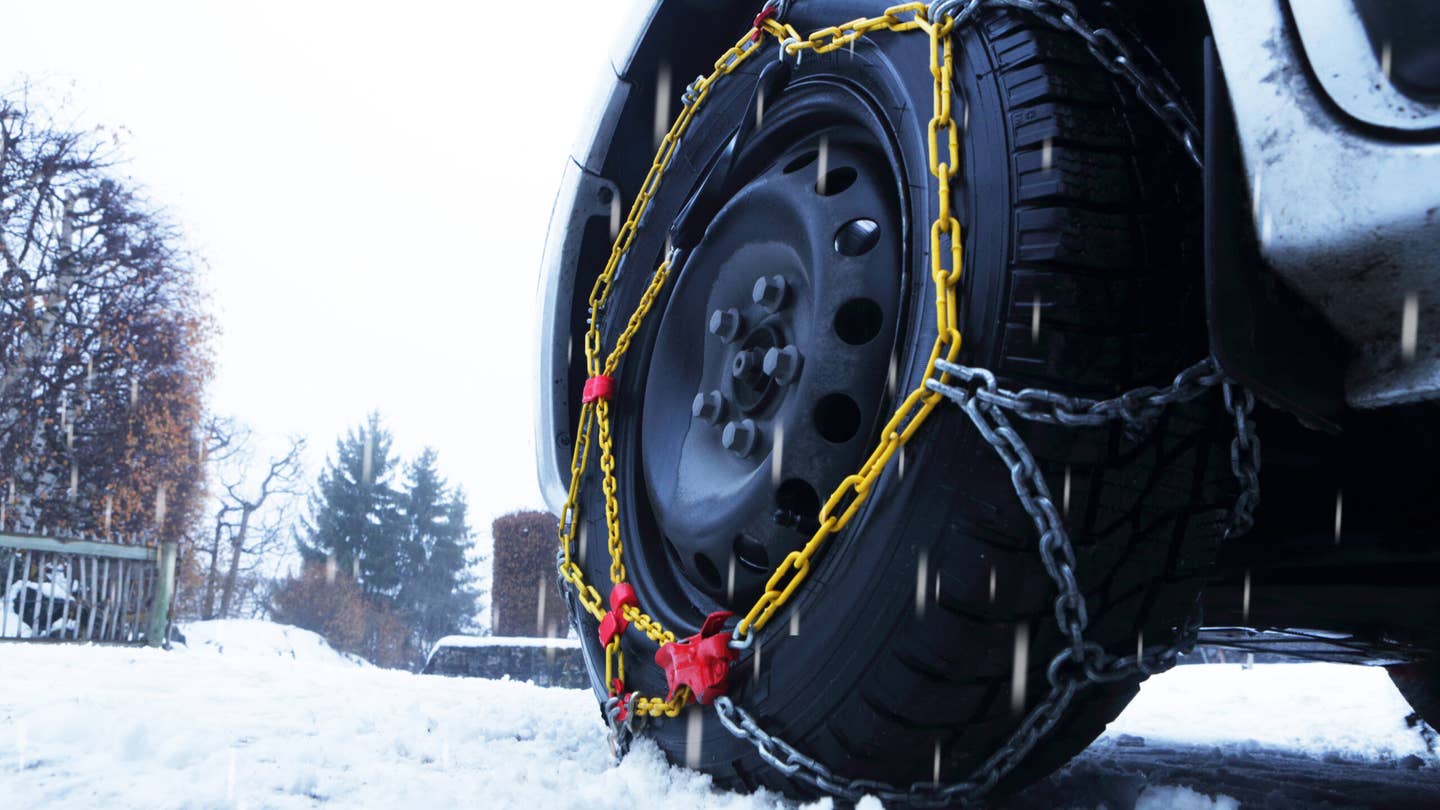An Introduction to Tire Chains for Snow
With winter here, it’s more important than ever to know how to use tire chains safely and which ones to choose for your car.

We may earn revenue from the products available on this page and participate in affiliate programs. Learn more ›
Winter is early, or right on time depending on your perception of the season. Either way, powdery water is falling out of the sky, and it’s officially time to start thinking about it and doing some winter weather preparation. And one of the most valuable driving tools for the winter is a set of tire chains.
Tire chains are the epitome of low-tech goodness. They're a specifically sized set of chains that wrap around the tires of your vehicle, aiding traction in icy and deep snow conditions. These chains are the final line of defense in the battle against slip in low-traction conditions. They outclass snow tires in the most extreme situations and are removable at will, unlike studded tires. The compromise they present is appealing to most drivers that live in harsher climates and probably see the most use as an add-on for all-season tires.
They do have compromises, however. Most obvious of which would be on-road performance and refinement. Chains add a tremendous amount of vibration, harshness, and noise to the driving experience of any car and aren’t supposed to be used all of the time. If the road is dry, clear, and not icy, it's best to rely on a good set of winter tires and you could actually be fined for using them. But when the going gets icy or packed deep with snow, chains offer an insurmountable advantage. Let's talk about tire chain basics.
The Drive and its partners may earn a commission if you purchase a product through one of our links. Read more.
The Different Kinds of Tire Chains
There are a few different kinds of chains, including some alternative traction options. But the two most popular are diamond-style chains that use metal chain links, and plastic tire chains that use a different pattern but serve the same purpose. There are also cable chains that feature a ladder-like design and use steel cables in place of chains.
I’ll go over each kind briefly and list out some pros and cons.
Diamond Tire Chains
A diamond chain is the most common and recognized version of a tire chain. It consists of a fitted set of chains that wrap around the tire in a diamond pattern. It’s a simple device: the chains effectively bite into the snow or ice and provide serious traction. Think of the difference between a really good hiking boot and an ice pick. Where winter tires will work exceptionally well in cold weather and snow, chains provide ultimate grip in deep snow and ice. These are best for situations in deep snow.
These Peerless Auto-Trac tire chains are a good example of diamond chains.

Plastic Tire Chains
Plastic tire chains are a newer version of tire chains that are becoming available for newer cars. They tend to wear quicker but work generally as well as metal chains, and come in a variety of patterns. Some are diamond, others are ladder-style, leaving plenty of options for the severity of weather in your locale. Benefits include quieter operation and easier installation compared to traditional chains, but they are still only meant to be used in severe conditions. They also tend to be more affordable than metal chains. These are best for medium or light snow, depending on the pattern.
A good example of a plastic tire chain is the composite Michelin chain system that uses belts and plastics to create a pseudo-tread pattern.
Cable Tire Chains
Cable chains are a less aggressive version of metal chains. Instead of using chain links, steel cables are used, usually encased in something protective. These are a middle ground between full-on chains and plastic chains, offering smoother and quieter operations but still requiring severe road conditions to be useful. These are much lighter but provide less of a traction advantage. Overall, cable chains are more suited to light and medium snow areas.
These Security Chain Company cable tire chains represent a good example of these chains.
Do you need tire chains?
The question of whether to tire chain or not tire chain comes down to a lot of factors. Principally, it’s down to the legality and required usage of chains on the roads your driving on. Some roads become chain controlled in the winter, especially after a weather event that can cause ice or snow. This means that chains are required to drive on those roads. In that case, having a set of snow chains is imperative.
But plenty of folks live far away from alpine winter wonderlands. If you live in a warm climate, the likelihood that you will ever need chains is low. Truthfully, the only reason for someone in Florida to have tire chains is if they’re planning a road trip to the Appalachians. But for someone who lives in Alaska, chains are indispensable. It’s one of those things that are worth keeping in the garage. Metal doesn’t expire, and they don’t take up much space.
That’s all there is to know about tire chains before making a purchase decision. Installing them is highly dependent on the manufacturer of the chains, thus their instructions are the best guide to follow. The makers of the chains also list their capabilities, including maximum speed and usage conditions.
Video

More From The Drive
- Jonathon Klein shows us how to change a fog light
- Here's what oil weight means and why it's important
- Which oil weight is best for your car?
- Hank O'Hop explains changing tires at home
